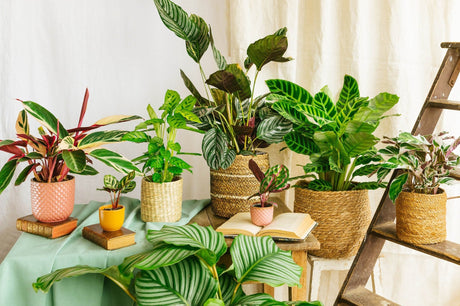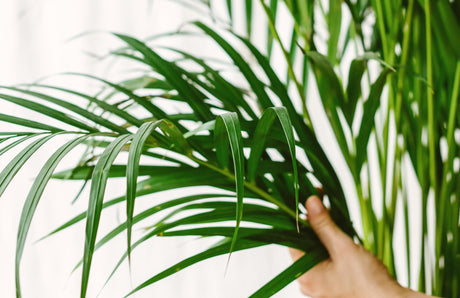Native of the tropical regions of Africa, this plant adapts perfectly to a domestic environment, bringing an exotic touch to your interior while allowing you to enjoy a unique culture experience.
The Coffee tree is recognizable by its shiny, green leaves, which add a touch of freshness to any space . When grown under optimal conditions, it can even bloom with delicate white, fragrant flowers.
1. Watering the Coffee Tree
Watering should be moderate. Avoid excess water, because the coffee tree prefers a soil slightly dry between waterings. Watering too excessive can cause problems of rot roots.The watering frequency may vary depending on the seasons. During the period of active growth (spring and summer), water more frequently. On the other hand, during the months autumn and winter, reduce the frequency of watering to allow the soil to dry out slightly between waterings.
Tip: Insert your finger into the ground to a depth of approximately 2-3cm . If the soil is dry at this depth, it is usually time to water it.
2. Watering techniques
Watering from below
Place the Coffee Tree pot in a saucer or tray and pour water into the saucer. Let the soil absorb the water by capillary action for a few hours. Be sure to empty the excess water in the saucer after a while to avoid stagnation.Slender Spout Watering Can
Gently and evenly water the soil around the plant. Make sure the water flows freely through the pot's drainage holes. Avoid watering the leaves directly to reduce the risk of fungal diseases.3. The Coffee Tree
exhibition The Coffee tree thrives in bright indirect light. Avoid exposure direct to sun, as the leaves can burn. Place your Coffee Tree near a window with a curtain light for filtering direct sunlight. Windows facing east or west are often ideal.To ensure uniform growth, turn regularly the pot of your Coffee Tree. This allows all parts of the plant to receive an equal amount of light. Perform a rotation a quarter turn every week.
4. When should I repot my Coffee tree?
Spring is generally the period most propitious for repotting the Coffee tree. As the days lengthen and temperatures rise, the plant enters a phase of growth active. So now is the time ideal to give your Coffee Tree space more large to expand and expand.
It is recommended to repot your Coffee tree every every 2 to 3 years. This allows the roots to benefit from new nutrients and space of growth increased.Here are some signs to watch out for:
Visible roots
If you notice that the roots are starting to protrude through the drainage holes of the pot or to form a dense network on the surface of the substrate, it is probably time to repot. Visible roots indicate that the current pot has become too small to accommodate root growth.Slowed growth
If your coffee tree has stopped growing significantly, has fewer new leaves, or is showing a lag in development, this may be a sign that the current pot no longer offers enough space or nutrients.Depleted Soil
The potting medium used in the pot can deplete over time, which means it loses its ability to retain moisture and provide the nutrients needed by the plant. If the substrate looks compact, dry or decaying, it may be time to repot.Frequent watering
If you need to water your coffee tree more frequently than usual because the soil dries out quickly, this may indicate that the pot has become too small to hold enough water and nutrients for the plant.Intertwined Roots
When you remove the plant from the pot, if you find that the roots are tightly intertwined, forming a compact ball, this is a sign that the Coffee tree is cramped in its current pot and needs some more space to grow.Yellowing or unhealthy leaves
Yellowing, withered or unhealthy leaves can be an indicator of plant stress. This may be due to a lack of root space or a depletion of nutrients in the substrate.Toggle or Jitter
If your coffee tree becomes unsteady in its current pot and topples over easily, it may be a sign that the roots have filled all the available space and it's time to repot in a larger container.5. What fertilizer should I use for my Coffee tree?
To feed your Coffee tree and promote its growth healthy, you can use a fertilizer balanced specifically designed for indoor plants.Heresome tips for choosing and using fertilizer for your Coffee Tree:
Dosage and frequency
Follow the manufacturer's instructions for recommended dosage on the fertilizer package. In general, dilute the fertilizer to half or three-quarters of the recommended strength to avoid overfeeding the plant. Apply fertilizer every 4-6 weeks during the active growing season (spring to fall).
Water before fertilizing
Before applying fertilizer, water your coffee tree with water. This avoids an excessive concentration of salts and nutrients around the roots.
Avoid the leaves
Avoid putting fertilizer directly on the leaves of the coffee tree, as this can cause burns or stains. The fertilizer must be applied to the soil so that the roots can absorb it.
6. How do I multiply my Coffee tree?
To multiply your Coffee Tree, you can use the method of cuttings in taking a healthy stems not flowering. Cut a section of stem approximately 10-15cm long, just below a node. Remove the bottom leaves to expose the nodes.
Place the cutting in a substrate light and well draining, ensuring that at least one node is buried. Hold the substrate slightly moist and place the cutting in a place bright, but out of direct sunlight. The roots should start to form within a few weeks.
7. Diseases of Coffee tree
The Coffee tree can be subject to several diseases, some caused by fungi , bacteria or parasites. Here are some common coffee tree diseases to watch out for:
Rust
This is one of the most feared diseases of the coffee tree. It causes orange or yellow spots to appear on the leaves, with spore pustules underneath. The disease can reduce photosynthesis and lead to yield loss.
Anthracnose
This fungal disease causes dark brown spots on leaves and branches. The spots can grow, coalesce and cause leaf drop.
Oidium
Powdery mildew is a fungal disease that manifests as a powdery white coating on leaves, stems, and buds. This can hinder plant growth and reduce photosynthesis.
Leaf spot disease
This disease causes circular brown to black spots to appear on the leaves, which can cause them to drop prematurely.
Root nematodes
Nematodes are small worms that attack the roots of the coffee tree, causing discoloration, reduced growth and susceptibility to other diseases.
Gray Mold
This fungal disease is manifested by the development of gray mold on injured or weakened plant parts, such as flowers or berries. It can cause rotting and major damage.
Bacterial necrosis
This bacterial disease causes dark, necrotic lesions on leaves and stems. It can spread quickly in wet conditions.
Phoma of the Coffee Tree
Phoma infections cause dark or necrotic spots on leaves, reducing the area for photosynthesis.
8. Delivery and reception of your plant
- Your plant is dry
- Is your plant wet ? Let the potting soil dry.
- Should I repot my plant right away ? No ! Wait until next spring or for signs that your plant needs repotting.






